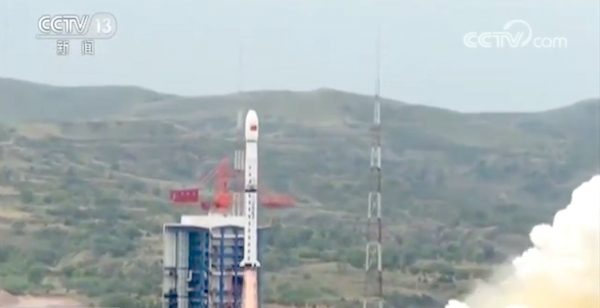China launches Earth-observing satellites, solar sail experiment – Spaceflight Now

Two Earth-imaging satellites and an experimental solar sail payload rocketed into orbit Thursday aboard a Chinese Long March 4B launcher, the first flight for China’s Long March 4 rocket family since an upper stage failure in May.
The liquid-fueled Long March 4B rocket lifted off from the Taiyuan space center in northern China’s Shanxi province at 0326 GMT Thursday (11:26 p.m. EDT Wednesday), according to state media reports.
The government-run Xinhua news agency reported the rocket placed three satellites into their planned orbits.
The 150-foot-tall (45-meter) Long March 4B rocket is powered by three stages, each consuming a mix of hydrazine and nitrogen tetroxide propellants. The Long March 4B uses a similar third stage design as the similar Long March 4C rocket, which failed to place a Chinese military payload into orbit during a launch attempt May 22.
Chinese officials blamed the May 22 failure on an unspecified problem with the third stage.
The Long March 4-series rockets are built by the Shanghai Academy of Spaceflight Technology, a subsidiary of the government-owned China Aerospace Science and Technology Corp. China’s other Long March rocket versions come from the China Academy of Launch Vehicle Technology, another government-run organization in China’s industrial apparatus.
The third stage blamed for the May 22 failure only flies on the Long March 4 family of rockets. Other Long March rocket variants continued flying while Chinese engineers investigated the Long March 4C launch failure, before officials cleared the similar Long March 4B for Thursday’s mission.
The primary payload on Thursday’s launch was the Ziyuan 1-2D Earth observation satellite developed by the China Academy of Space Technology.
Designed for civilian applications, the Ziyuan 1-2D satellite is a follow-up to the Ziyuan 1-2C satellite launched in 2011.
During a planned five-year mission, the Ziyuan 1-2D satellite will fly in a polar sun-synchronous orbit at an altitude of 483 miles (778 kilometers), according to Xinhua. The spacecraft carries a near-infrared camera to observe large and medium-sized cities, collecting imagery to aid urban planning, state media reported.
The spacecraft also has a 166-band hyperspectral camera, an instrument with the sensitivity to distinguish between different types of surface materials and mineral compositions.
The Ziyuan 1-2D satellite will support applications including “natural resources asset management, ecological monitoring, disaster prevention and control, environmental protection, urban construction, transportation and contingency management,” Xinhua said.
“The satellite can also be used to observe chlorophyll concentration, water transparency and total suspended matter concentration in lakes to help monitor the environment and prevent water pollution,” Xinhua said.
Two secondary payloads also rode the Long March 4B rocket into orbit Thursday, according to China Great Wall Industry Corp., the state-owned company charged with marketing Long March launch services for international, university and commercial satellites.
One of the auxiliary satellites, a 35-pound microsatellite led by Beijing Normal University, will monitor polar shipping channels and collect environmental data in the Arctic and Antarctic regions.
Named Ice Pathfinder, or BNU-1, the satellite was developed by Shenzhen Aerospace Dongfanghong Development Ltd., and will be operated by the Chinese University Corporation for Polar Research. The Ice Pathfinder spacecraft carries high-resolution cameras to track changes in sea ice, and also hosts an instrument to identify ships traversing polar seas.
Chinese officials said Ice Pathfinder is the first spacecraft in a planned constellation of 24 microsatellites to provide continuous polar observations. China currently relies on foreign satellites and ground monitoring stations for polar observations.
The third payload aboard Thursday’s launch was Taurus 1, a Chinese CubeSat to test a solar sail system that could be used to de-orbit small satellites.
Email the author.
Follow Stephen Clark on Twitter: @StephenClark1.






